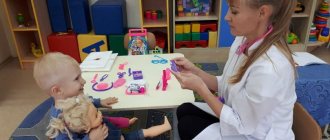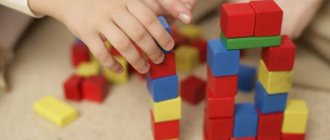A game. The main stages of play activity in preschool age. article
Leading activity
The leading activity in preschool age is play.
A game is a form of activity in which a child reproduces the basic meanings of human activity and assimilates those forms of relationships that will be realized and implemented later. He does this by replacing some objects with others, and real actions with abbreviated ones. Role-playing games are particularly developed at this age. The basis of such a game is the role chosen by the child and the actions to implement this role.
D.B. Elkonin argued that a game is a symbolic-modeling type of activity in which the operational and technical side is minimal, operations are reduced, and objects are conventional. It is known that all types of preschooler activities are of a modeling nature, and the essence of modeling is the recreation of an object in another, non-natural material.
The subject of the game is an adult as a bearer of some social functions, entering into certain relationships with other people, adhering to certain rules in his activities.
In the game, an internal action plan is formed. This happens as follows. The child, while playing, focuses on human relationships. In order to reflect them, he must internally play out not only the entire system of his actions, but also the entire system of the consequences of these actions, and this is only possible by creating an internal plan of action.
As shown by D.B. Elkonin, play is a historical education, and it arises when a child cannot take part in the system of social labor, because he is still too small for this. But he wants to enter adulthood, so he does this through play, having a little contact with this life.
A game
While playing, the child not only has fun, but also develops. At this time, the development of cognitive, personal and behavioral processes occurs.
Children play most of the time. During the period of preschool childhood, play goes through a significant development path.
The main stages of play activity in preschool age
Younger preschoolers play alone. The game is objective-manipulative and constructive in nature. During the game, perception, memory, imagination, thinking and motor functions are improved. In a role-playing game, the actions of adults, whom the child observes, are reproduced. Parents and close friends serve as role models.
In the middle period of preschool childhood, a child needs a peer with whom he will play. Now the main focus of the game is simulating relationships between people. Themes of role-playing games vary; Certain rules are introduced, which the child strictly adheres to. The focus of the games is varied: family, where the heroes are mother, father, grandmother, grandfather and other relatives; educational (nanny, kindergarten teacher); professional (doctor, commander, pilot); fairy tale (goat, wolf, hare), etc. Both adults and children can participate in the game, and they can be replaced with toys.
In older preschool age, role-playing games are distinguished by a variety of themes, roles, game actions, and rules. Objects can be conditional in nature, and the game turns into symbolic, that is, a cube can represent various objects: a car, people, animals - it all depends on the role assigned to it. At this age, during play, some children begin to show organizational skills and become leaders in the game.
During the game, mental processes develop, in particular voluntary attention and memory. If a child is interested in a game, then he involuntarily focuses on the objects included in the game situation, on the content of the actions being played out and the plot. If he is distracted and does not perform his assigned role correctly, he may be expelled from the game. But since emotional encouragement and communication with peers are very important for a child, he has to be attentive and remember certain game moments.
In the process of gaming activity, mental abilities develop. The child learns to act with a substitute object, that is, he gives it a new name and acts in accordance with this name. The appearance of a substitute object becomes a support for the development of thinking. If at first, with the help of substitute objects, the child learns to think about a real object, then over time, actions with substitute objects decrease and the child learns to act with real objects. There is a smooth transition to thinking in terms of ideas.
During the role-playing game, imagination develops. From replacing some objects with others and the ability to take on different roles, the child moves on to identifying objects and actions with them in his imagination. For example, six-year-old Masha, looking at a photograph of a girl who rests her finger on her cheek and thoughtfully looks at a doll sitting near a toy sewing machine, says: “The girl thinks as if her doll is sewing.” Based on this statement, one can judge the girl’s typical way of playing.
Play also influences a child’s personal development. In the game, he reflects and tries on the behavior and relationships of significant adults, who at this moment act as a model of his own behavior. Basic communication skills with peers are formed, feelings and volitional regulation of behavior are developing.
Reflective thinking begins to develop. Reflection is a person’s ability to analyze his actions, actions, motives and correlate them with universal human values, as well as with the actions, actions and motives of other people. The game promotes the development of reflection because it makes it possible to control how an action that is part of the communication process is performed. For example, when playing hospital, a child cries and suffers, playing the role of a patient. He gets satisfaction from this because he believes that he played the role well.
Interest in drawing and design arises. At first, this interest manifests itself in a playful form: the child, while drawing, acts out a certain plot, for example, the animals he has drawn fight among themselves, catch up with each other, people go home, the wind blows away apples hanging on the trees, etc. Gradually, the drawing is transferred to the result of the action , and a drawing is born.
Learning activities begin to take shape within the play activity. Elements of educational activities do not arise in the game; they are introduced by an adult. The child begins to learn through play and therefore treats learning activities as role play, and soon masters some learning activities.
Since the child pays special attention to role-playing play, let’s consider it in more detail.
A role-playing game is a game in which the child plays the role he has chosen and performs certain actions. Children usually choose plots for games from life. Gradually, with changes in reality, acquisition of new knowledge and life experience, the content and plots of role-playing games change.
The structure of the expanded form of a role-playing game is as follows.
1. Unit, center of the game. This is the role that the child chooses. In children's play there are many professions, family situations, life moments that made a great impression on the child.
2. Game actions. These are actions with meanings; they are figurative in nature. During the game, meanings are transferred from one object to another (an imaginary situation). However, this transfer is limited by the possibilities of showing the action, since it is subject to a certain rule: only an object with which it is possible to reproduce at least a picture of the action can replace an object.
The symbolism of the game is of great importance. D.B. Elkonin said that abstracting from the operational and technical side of objective actions makes it possible to model a system of relations between people.
Since the game begins to model a system of human relationships, the need to have a comrade arises. You cannot achieve this goal alone, otherwise the game will lose its meaning.
In the game, the meanings of human actions are born, the line of development of actions goes as follows: from the operational scheme of action to human action that has meaning in another person; from a single action to its meaning.
3. Rules. During play, a new form of pleasure arises for the child - the joy that he acts as the rules require. When playing hospital, a child suffers as a patient and rejoices as a player, satisfied with the fulfillment of his role.
D.B. Elkonin paid great attention to the game. Studying the games of children aged 3–7 years, he identified and characterized four levels of its development.
First level:
1) actions with certain objects aimed at an accomplice in the game. This includes the actions of the “mother” or “doctor” directed towards the “child”;
2) roles are determined by action. The roles are not named, and the children in the game do not use in relation to each other the real relationships that exist between adults or between an adult and a child;
3) actions consist of repeated operations, for example, feeding with the transition from one dish to another. Apart from this action, nothing happens: the child does not replay the process of cooking, washing hands or washing dishes.
Second level:
1) the main content of the game is action with an object. But here the correspondence of the game action with the real one comes to the fore;
2) the roles are called children, and a division of functions is outlined. Fulfillment of a role is determined by the implementation of actions associated with a given role;
3) the logic of actions is determined by their sequence in reality. The number of actions is expanding.
Third level:
1) the main content of the game is the execution of actions arising from the role. Special actions begin to stand out that convey the nature of the relationship with other participants in the game, for example, turning to the seller: “Give me some bread,” etc.;
2) roles are clearly defined and highlighted. They are called before play, determine and guide the child’s behavior;
3) the logic and nature of actions are determined by the role taken. Actions become more varied: cooking, washing hands, feeding, reading a book, going to bed, etc. Specific speech is present: the child gets used to the role and speaks as required by the role. Sometimes during the game, real-life relationships between children may appear: they begin to call names, swear, tease, etc.;
4) the violation of logic is protested. This is expressed in the fact that one says to the other: “It doesn’t happen like that.” The rules of behavior that children must obey are determined. The incorrect execution of actions is noticed from the outside, this causes grief in the child, he tries to correct the mistake and find an excuse for it.
Fourth level:
1) main content - performing actions related to relationships with other people, whose roles are performed by other children;
2) roles are clearly defined and highlighted. During the game, the child adheres to a certain line of behavior. The role functions of children are interconnected. The speech is clearly role-based;
3) actions occur in a sequence that clearly recreates real logic. They are varied and reflect the richness of the actions of the person portrayed by the child;
4) violation of the logic of actions and rules is rejected. The child does not want to break the rules, explaining this by the fact that this is actually the case, as well as the rationality of the rules.
Games for preschoolers
The age of preschoolers can be divided conditionally into younger and older. At a young age, children's games are aimed at learning the properties of things and various connections. By the senior preschool period, children have new needs, so preference is given to role-playing games with peers. Already in the third year of life, children develop an interest in group games. Cognitive, active or manipulative games occupy a significant place in the preschool period. Children love to play with construction sets, as well as with a variety of available materials (household furniture, sand, clothes, etc.). At the beginning, collective play, in fact, is not such a thing - each child plays on his own with his own toys, not paying attention to the children playing nearby. However, at some point it suddenly turns out that the game is already general, with certain rules and aimed at solving the problem set by the children themselves. Gradually, preschoolers' play activities change noticeably - their creativity begins to develop, and they want to share it. Children exhibit organizational abilities to varying degrees; they already need play with a plot. Older preschoolers begin to be attracted to games that reflect the lives of adults; the most typical of these can be called games of “mother-daughter,” “school,” and “hospital.”
Play and development of children's speech
Play even significantly influences the development of a child’s speech. A minimum level of communication skills is necessary so that the child can confidently connect to a gaming situation. Thanks to the need to communicate with other children, the development of coherent speech is stimulated. In play, which is the leading form of activity at this age, the sign function of speech intensively develops due to the replacement of one object with another. Placeholder objects serve as symbols for missing items. Any real object that replaces another object can serve as a sign. The proxy object transforms the verbal definition by associating the word with the missing object. Thanks to play, the child begins to perceive individual and iconic signs. In iconic signs, the sensory properties are virtually close to the object being replaced, and the sensory nature of individual signs has little connection with the designated object. Games are also important for developing reflective thinking. For example, a child playing hospital cries and suffers like a patient, although internally he enjoys playing the role.
Didactic games
The most important importance of play activity is the development of children in its process. Didactic games conducted by teachers directly serve this purpose. These games are specially invented for training and education; they have certain rules and a specific result is expected. In fact, a didactic game is a synthesis of a form of learning and play. It sets didactic tasks, defines rules and game actions, and predicts the result. The didactic task refers to the educational impact and purpose of learning. It is well demonstrated by games that reinforce the ability to form words from letters or counting skills. The task in a didactic game is carried out through game actions. The game is based on the play actions carried out by the children themselves. The more interesting these actions are, the more effective and exciting the game will be. The teacher who controls the behavior of children sets the rules of the game. When the game ends, it is necessary to sum up its results. This may mean determining the winners who completed the task best, but at the same time it is necessary to encourage each participant in the game. Adults use didactic games as a way of learning, allowing a smooth transition from gaming to educational activities.





